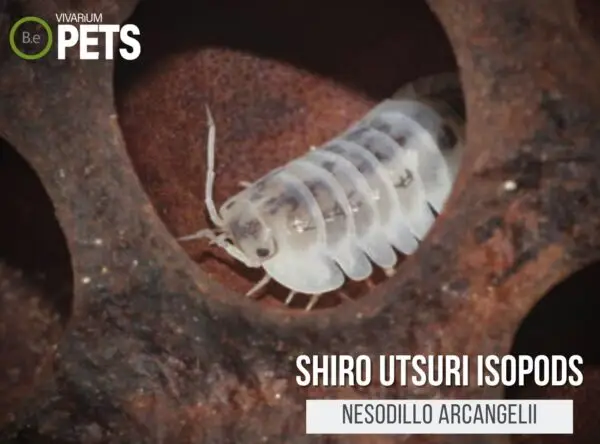We often think about the beauty and mysteriousness of the creatures inside our terrariums, but few are aware of the hidden gem that is the Shiro Utsuri Isopod aka Silver Ghost Isopod.
Scientifically known as Nesodillo Arcangelii and formerly known as Cubaris sp., this isopod is an extremely versatile species.
It is also a source of natural beauty and curiosity. In this article, we’ll take a closer look and explore the fascinating world of the Shiro Utsuri Isopod.
| Characteristics: | |
|---|---|
| Common Name | Shiro Utsuri Isopod, Silver Ghost Isopod |
| Family Name | Armadillidae |
| Scientific Name | Nesodillo arcangelii |
| Use | Cleaning, Aerating Soil, Feeders |
| Temperament | Non-aggressive |
| Lifespan | 2-3 Years |
| Diet | Detritivore |
| Adult Size | 1-2 cm |
| Breeding Type | Egg Layer |
| Care Level | Easy |
| Minimum Tank Size | 10 Gallons |
| pH | 5.5-7.5 |
| Hardness | Soft |
| Temperature | 68-80°F |
Table Of Contents:
ToggleWhat Is A Shiro Utsuri Isopod?
The Shiro Utsuri Isopod is a crustacean of the Armadillidae family, known as the “Silver Ghost Isopod” as well as the “Shiro Utsuri Isopod”.
This species is native to Taiwan. They are recognizable by their unique coloration and glistening skin, the result of the black and white coloring on their outer shell.
The common name “Shiro Utsuri” is derived from Japanese and translates to “White Pattern,” as it closely resembles the black and white Japanese Koi.
What Does Shiro Utsuri Isopod Look Like?
Shiro Utsuri Isopods have a smooth, cylindrical body and an oval shape with seven pairs of legs. They are small, typically ranging in size from just a few millimeters to a maximum of around two centimeters.
They have an upside-down Y-shaped pair of antennas and two pairs of antennae near the back of their head. The vivid silver color of the Shiro Utsuri Isopod is unique and striking.
A solid, white base serves as a backdrop for irregularly arranged dark blue-green spots, the origins of their common name.
As the isopods mature, the colored spots become more pronounced and larger. The shiny texture is due to the hydrophobic layer on the exoskeleton that is present in all isopods.
Benefits Of Using Shiro Utsuri Isopod
Silver Ghost Isopods offer a number of key benefits when used in vivariums. They can help with detritus management, feeding on waste and uneaten food thereby helping to break down organic matter and adding nutrients to the substrate.
They also help keep tanks clean by eating algae, which can be beneficial in a terrarium as it encourages the growth of a wide variety of plants.
Shiro Utsuri Isopods are also important for providing a natural food source for larger tank mates, such as frogs, snakes, salamanders, and lizards.
Furthermore, they provide an interesting addition to any type of enclosure, making them an aesthetically pleasing decoration for the habitat.
They can also be used to cycle a tank and help to establish beneficial bacteria to help stabilize tank water levels and keep the biological system healthy.


Shiro Utsuri Isopod Facts
Shiro Utsuri Isopods are detrivorous crustaceans native to Taiwan, displaying a kind temperament. They typically live two to three years and reproduce quickly when properly cared for.
These isopods prefer relatively neutral environments with temperatures ranging from 68-78 degrees Fahrenheit.
Habitat
Nesodillo Arcangelii is native to Taiwan where they are found around areas of shallow ponds and streams. This species is commonly scavenging among the leaf litter and rocky crevices of these waters.
The Shiro Utsuri Isopod prefers mild temperatures and a slightly acidic environment, with temperatures ranging from 50°F-75°F, and a pH level of 5 to 6.5.
They are primarily an active species and can be observed foraging for algae and decaying vegetation throughout the day.
Since they are nocturnal, they can also be seen at night, searching around their habitat. They will even take bits of food off of a human fingertip if presented.
Diet
The Shiro Utsuri Isopodis an detrivore that forages for both decaying organic matter and lives microfauna prey in its native environment.
These scavengers naturally feed on smaller dead invertebrates such as worms, mollusks, and crustaceans.
They may also occasionally feed on detritus such as plant and algae material as well as any fecal matter they can find.
Temperament
When kept as pets, Shiro Utsuri Isopods are generally considered non-aggressive and non-toxic. They’re great additions to a tank if you’re looking for a pet that is low-maintenance but still fascinating to watch.
They tend to hide during the day and come out at night to feed on algae and other organic matter. Since they are very much hands-off pets, they do not require much interaction with people. However, they are curious and may come out to explore if someone is nearby.
Lifespan
The lifecycle of a Shiro Utsuri Isopod is considered rather quick compared to other isopods of its kind. Under optimal conditions, they tend to live up to a year or more.
The female isopod will lay eggs and each egg will hatch within the span of a few weeks. The baby isopods are miniature versions of their adult selves, just in smaller form.
These young isopods continue to grow with regular molts until the full adult size is reached. They typically reach sexual maturity after 3-4 molt cycles.
Once a Shiro Utsuri Isopod has reached maturity, it begins to age on a gradual basis. Its progression toward the end of its lifecycle is marked by generally slower growth and a reduced ability to reproduce.
With proper care, these isopods can live upwards of almost 2 years or more.
Breeding
Shiro Utsuri Isopods mate and reproduce in a similar manner to other Isopod species. They are typically able to reproduce within two to three months of reaching maturity.
This is marked by the molt of their exoskeleton and the start of their adult coloring. This molt can happen multiple times before a mating pair is ready.
Mating pairs are formed when two adults are prepared to reproduce. During mating, the male will climb onto the female’s back and grasp onto her with his front claws.
He will then insert his sperm into her reproductive system, releasing a spermatophore that is transferred to the female.
Upon mating, the female will carry the eggs in a ventral marsupium beneath her thorax. This pouch serves to protect the eggs from harm and will continue to protect them as they develop.
After a few weeks, the young will hatch from their eggs and can immediately start to feed on the substrate around them. They will then continue to molt and grow until they reach maturity themselves.
Where To Find Shiro Utsuri Isopods
Shiro Utsuri Isopods are most commonly found near shallow bodies of freshwater in and around Taiwan. These areas include brackish water, streams, and ponds.
If you’re looking for an easier way to catch them, consider buying specimens online. Online stores offer Shiro Utsuri Isopods that are already raised and cultured in captivity.
They can be purchased and added to your terrarium with ease. In addition, buying from an online store will guarantee the quality of the specimens, since the health of wild-caught isopods can be difficult to guarantee.
Shiro Utsuri Isopod Care
Shiro Utsuri Isopods should be provided with a temperature between 72-82F in a clean, damp environment.
They need to be given a varied diet that includes vegetable parts, decaying matter, fungi, and small amounts of fruit.
Regular water changes should be done with dechlorinated water to maintain a safe habitat for them.
Tank Requirements
The ideal tank for Shiro Utsuri Isopods should be a terrarium-type setup, with a substrate layer of mixed terrarium soil and peat moss.
The water should be kept at a neutral pH level (7.0) and a medium hardness (0-10 KH), while the temperature should range from 72-79°F (22-26°C).
All tanks should have appropriate terrarium lighting, including a 12-hour light/dark cycle and even levels of ambient light throughout the day. Shiro Utsuri Isopods are nocturnal and do not require bright light for their health.
A separate hiding area with some substrate under driftwood or other terrarium rocks will provide them with the right amount of darkness.
Some containers such as PVC tubes and ceramic dishes can also be used to provide additional security.
What Do Shiro Utsuri Isopods Eat?
The Shiro Utsuri Isopods, or Silver Ghost Isopods, are relatively easy to care for in your vivarium setup. They require a balanced and varied diet to stay healthy and thrive. To feed these isopods, use these food items as staples:
- Fish food flakes
- Algae wafers
- Dried plant material
- Pear slices
- Raw vegetables, such as carrots and squash
- Canned vegetables, such as peas and corn
- Fruits, such as strawberries and blueberries
You should also consider supplementing their diet with other food sources, such as fish or shrimp pellets and freeze-dried or frozen foods, to encourage better health and stimulate natural behavior.
To give them a natural experience, also offer them pieces of wood and dead leaves for foraging. Finally, to ensure that your Shiro Utsuri Isopods are well-fed, provide them with small meals regularly.
If you’re more of an avid hobbyist like myself, be sure to check out my ultimate DIY Isopod food guide. I give a more in-depth explanation of the best foods and my personal favorite recipe.
Best Tankmates For Shiro Utsuri Isopods
Shiro Utsuri Isopods typically do best when kept with other invertebrates. Their tankmates should also be peaceful and non-predatory, as any aggressive tankmates may harm the Isopods.
Good tankmates for Shiro Isopods include snails and millipedes. They can also be kept with other Isopods, such as the Armadillidium or Porcellio. Some of their other beneficial tankmates include woodlice, springtails, and sludge worms.
When selecting tankmates for Shiro Utsurii Isopods, be sure to pick animals that prefer similar water conditions. All of their tankmates should have the same temperature, pH, and hardness requirements.
Conclusion
In conclusion, the Shiro Utsuri Isopod is an incredible and rare species that can provide your aquascape with beauty and excitement. With the proper knowledge, you can create the ideal environment for your isopod.
You may even be able to observe it during its life cycle. The Shiro Utsuri Isopod is a worthwhile addition to any terra-scape and is a species that is truly unique and fascinating.
Frequently Asked Questions
Shiro Utsuri is a black and white Koi fish variety, characterized by its base color of white with a unique, black pattern or swirl. They are among the most popular and sought–after fish in the Koi industry and are renowned for their striking looks. It is an ideal fish for a pond and can reach lengths of up to 36 inches in length.
The scientific name for Shiro Utsuri isopod is Nesodillo Arcangelii which was formerly known as Cubaris Sp.
The Shiro Utsuri isopod typically grows to around 2cm in size.
Nesodillo Archangelii need a moist substrate with high humidity, ideal temperature of 70°–85°F, hiding spots, food sources such as organic fruit, leaf litter, and vegetable matter, as well as a shallow water dish. Clean the enclosure regularly and check for mold, fungi, and parasites.

